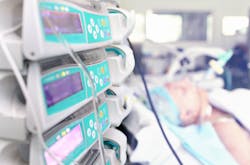Earlier this month, the Cleveland-based University Hospitals (UH) announced the implementation of a real-time surveillance technology system, designed to support higher-acuity patient care. Utilizing mobile technology, the system, called Advanced Clinical Guidance (ACG)-Remote View ICU from Talis Clinical, an Ohio-based software solutions provider, aims to facilitate easy integration of all patient monitoring equipment in the ICU environment.
According to officials from University Hospitals, an integrated network of 18 hospitals, more than 40 outpatient health centers and 200 physician offices throughout northern Ohio, the health system is among the first in the nation to implement a new real-time patient surveillance system being used to care for COVID-19 patients in the ICU.
Patients in the ICU are traditionally monitored by multiple devices, which are often disjointed and don’t communicate the patient’s vital statistics in a uniform way or to a central command. But via this new technology system, a small box connected to the patient’s bed sends data to a cloud, and is then accessed through a dashboard on a mobile device. The doctor or nurse can thus monitor the patient’s vital information minute-by-minute from anywhere on the floor or even remotely outside the hospital, according to UH officials.
Healthcare Innovation Managing Editor Rajiv Leventhal recently spoke with Peter Pronovost, M.D., UH chief clinical transformation officer, and Jeff Sunshine, M.D., UH chief medical information officer (CMIO), about the implementation of this platform, why it’s especially significant in the face of the pandemic, and how the organization will measure success. Below are excerpts of that interview.
Can you detail the impetus behind implementing this real-time surveillance technology system in this current moment?
Dr. Sunshine: I’d like to first give credit to Dr. Pronovost, who has long championed putting a surrounding web to help patients and providers stay healthy under all sorts of circumstances. He was also somewhat aware some of the technology and was able to connect with us here with a local company [Talis Clinical]. One of the fundamental things the pressure of COVID did was ask us to deliver care for very sick people while keeping them in relative isolation from others. So we have that duality of intense needs, but with separation, and we’re doing that in both the broad sense with the geographic location of patients in particular units, but also by reducing the necessary contact between caregivers and patients. Technology is just fantastic for that, and being internet- and web-enabled lets us jump across geographies.
Dr. Pronovost: Healthcare is largely under engineered and hasn’t fully embraced systems engineering as an approach. I [compare it to] building a plane, and whichever company was building it ordered the wings, hub, engine and landing gear, and just hoped that it all fit together. They wouldn’t do that, of course; they would have someone design it so all those pieces communicate.
So in healthcare, we have inherited a system like this [in which] devices do not communicate. It would be like United Airlines telling the developer of landing gear that they need to send a signal to the cockpit so the pilot could know if the landing gear is up or down, but the landing gear company [refuses] because it’s their data, and tells the pilot to instead look out the window. That’s basically how we have built technology in hospitals—they have all been in siloes. This [Remote View ICU] technology fundamentally breaks that model. It integrates data from a variety of different devices, puts it into context-sensitive [formats] so we can ensure compliance with best practices, and does it in a very concrete way.
For acute respiratory distress syndrome (ARDS), the NIH has spent billions of dollars and several decades studying this disease, and the main finding that saves lives is that if we give people [ventilator-delivered] breaths based on how tall they are, rather than how much they weigh, we can [reduce] stress on the lungs that causes injury. That [approach] reduces mortality from 40 percent to 31 percent, and yet we give those life-saving breaths [based on height], on average, just 20 percent of the time, per most estimates. The main reason for that is the data on how tall you are is stored in the medical record, but the data on how big of a breath you are getting is in the ventilator, and those two devices previously didn’t talk. So the ventilator is happily pumping away based on the order that was sent, not having a hardwired connection to say, [these breaths] are too big. But we can give the appropriate breaths based on how tall you are simply by connecting the landing gear to the cockpit.
Can you explain the process of what goes into linking these difference devices?
Sunshine: We are first doing it room-by-room in five selected ICUs, and the ones we concentrated on have our COVID patients who need ICU care. Within a particular ICU, in a room, we are leveraging the collected information that’s typically in an ICU monitor—basic respiratory rate, EKG, blood pressure, pulse oximetry, and we are taking those feeds in a particular room and linking a separate machine—the ventilator, which is built by a different company—to those devices, along with with the computer systems that know not only patient information and demographics, but key lab values, too.
So we collect that information, and importantly, it’s not just the [numbers], but it’s a high-frequency representation of the actual waveforms. That’s important for an intensive critical care doctor to see those real-time, dependent changes, rather than just summary information. And all that is taken with our corporate partner, Talis Clinical, into a central set of servers in the cloud that normalizes the information across the different vendors. We may have [multiple] ventilators from the same company, and they might all have different software on them, but regardless of all that variation, it’s normalized. Our intensivist can then see this information graphically and numerically. And most excitedly, we can then start applying clinical guidelines and thresholds to that information.
We are in the last stage of validation, and obviously before we want people making clinical decisions, we want to triple check that our capture is actually normalized correctly and presenting. The plan is to show this to clinicians and then start using it right after that. But the connections are already set up in the ICUs.
Pronovost: We have very mature evidence in healthcare about what things should work and don’t work, but you often have to integrate many data sources. There is a whole list of other displays so we can ensure that patients are receiving care compliant with best practices. Then we can create a much more reliable system that ensures quality by the design of safe systems rather than the heroism of our clinicians.
How will you measure success, both in the near- and long-term?
Sunshine: In IT, I always say that we look past the first thing that we shouldn’t look past, and that’s adoption. If we built something that we believe will help our clinicians, we first need to make sure that they’re actually looking at it, and not that it’s just flying there. It’s easy to look past that since clinicians are very busy, and in many ways overstimulated human beings. They don’t lack for data flying at them; they lack for appropriately filtered and integrated information that’s helpful. So the first measure we will look at is if our intensivists and nurse leaders in intensive settings are taking advantage of this. Once we do that we can also look at basic compliance with clinical goals. For example, how often are we achieving giving breaths in a certain range or maintaining blood pressure according to guidelines?
The longer-range metrics always will always be about how our patients are doing. Can we reduce the amount of time someone needs to be in intensive care? Can we improve and shorten the rate in which they are going home? How well are people surviving? These are longer-term metrics we will want to get to when we measure success in this space.
Pronovost: Is it deployable and is it usable? Some of that requires iterations about what the displays look like, and we have spent a lot of time with our clinicians and team configuring that. The next level is about the process measures; are we more compliant with best practices? And ultimately, do the outcomes, including cost data, really add value for those we serve?


